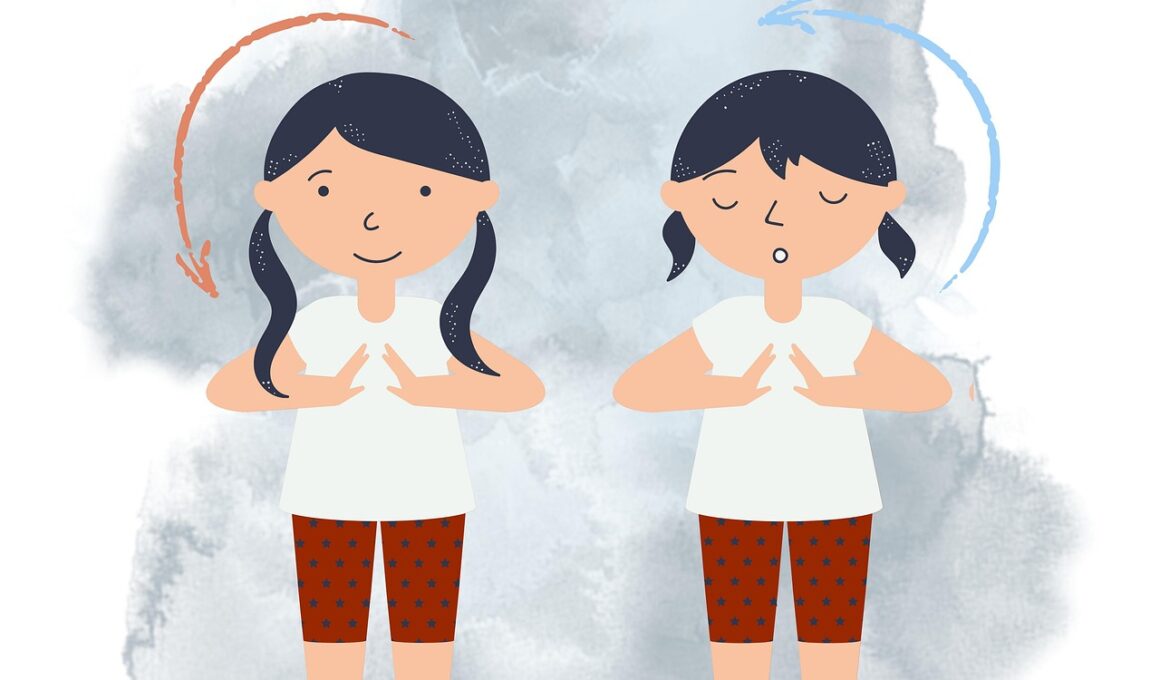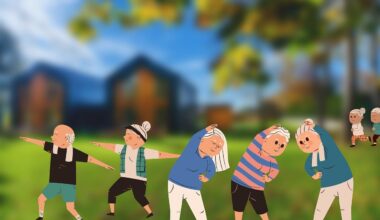The Role of Breathing in Posture Rehabilitation Programs
Breathing is a fundamental aspect of our body mechanics and has a significant impact on posture. Proper breathing techniques can enhance the body’s natural alignment processes. By promoting relaxation through deep breathing, individuals can release tension in muscles, which in turn positively affects their posture. Often, poor posture arises from various factors including stress and fatigue, which can result in shallow breathing. Moreover, emphasizing diaphragmatic breathing encourages the proper engagement of core muscles, which support the spine. Effective rehabilitation programs incorporate these breathing techniques, enabling better alignment and reducing discomfort. Additionally, engaging in various breathing exercises can help in increasing lung capacity, promoting better oxygenation of muscles, which supports overall physical performance. Furthermore, mindfulness-based breathing exercises allow individuals to become more aware of their bodies, improving their ability to identify posture-related problems. By including breathing techniques into regular physical therapy routine, rehabilitative practices can yield improved results faster. As the brain communicates with the body during deep, controlled breathing sessions, it helps to balance the nervous system, further enhancing the effectiveness of posture rehabilitation efforts. Ultimately, exploring breathing’s role in posture rehabilitation merits serious attention.
Breathing techniques significantly contribute to our posture physical well-being. When assessing posture, it’s crucial to understand how breath affects body alignment. Incorporating breath awareness helps individuals notice their physical tensions and habitual patterns that compromise postural alignment. The connection between breath and movement is vital, as the right breath can coordinate with physical activities, enhancing one’s overall functional mobility. The practice of yoga and Pilates often emphasizes synchronization of breath with movements, reinforcing proper posture. Engaging in exercises like these allows individuals to cultivate strength while maintaining awareness of their posture under different scenarios. Additionally, when the body is under stress, people often resort to shallow breathing, which can exacerbate posture-related issues. By applying specific breathing techniques, individuals can effectively manage stress and tension. Consistently practicing focused breathing exercises promotes an overall sense of balance within the body, which is foundational for achieving optimal posture. Utilizing techniques such as the 4-7-8 method or box breathing strengthens the connection between breath and muscle engagement, enhancing stability and alignment during daily activities. Ultimately, breath awareness serves as a valuable tool in the enhancement of posture improvement strategies.
Enhancing Core Stability Through Breathing
Core stability plays a critical role in maintaining proper posture, and breath control can enhance this significantly. Engaging the diaphragm effectively during breathing patterns can lead to increased intra-abdominal pressure. By stabilizing the core muscles through targeted breathing techniques, individuals create a supportive environment for the spine and pelvis. Diaphragmatic breathing, for example, aids in activating core muscles while simultaneously relaxing others, encouraging a balanced posture. This practice indirectly informs the body on how to maintain an upright position efficiently. Specialized exercises integrating breath and core engagement can significantly complement posture rehabilitation programs. As practitioners guide individuals towards learning these methods, noticeable improvements in body alignment can emerge. Moreover, understanding the coordination between breath and movement can aid individuals in achieving better postural control during functional movements. By practicing core-stabilizing exercises alongside focused breathing, the body learns to uphold an optimal posture dynamically. This interaction between breath and strength fosters confidence in everyday activities, reducing the risk of injury. Developing robust core stability through effective breathing reinforces the importance of both principles in achieving long-term posture enhancement.
Integrating breathing methods into physical therapy programs ensures that rehabilitation is holistic and beneficial. As professionals assess patients for posture-related issues, they can tailor breathing activities to complement individualized rehabilitation plans. The aim is to facilitate both relaxation and engagement of muscles crucial for maintaining proper alignment. Consider encouraging patients to practice controlled breathing exercises daily, allowing them to gradually improve their attention to posture throughout various activities. This conscious approach fosters mental and physical awareness, equipping individuals with tools for enhancing posture. Furthermore, the use of biofeedback mechanisms can augment the process. By helping individuals visualize where tension resides, they can use breath-focused techniques to alleviate discomfort. Incorporating technology into therapy sessions, such as apps that promote breath exercises, can enhance patient adherence. Regular monitoring can yield tangible results over time, showcasing the transformative impact of these practices. Additionally, family members and caregivers can be educated to encourage supportive environments. This holistic approach not only elevates the rehab experience but also promotes lasting changes that strengthen future postural habits. Ultimately, integrating breathing techniques empowers individuals to take control of their well-being positively.
Breath and Balance: Connection to Posture
Breath awareness fosters a strong connection to balance, influencing overall posture significantly. Our breath serves as a bridge between mind and body, affording individuals the ability to sense imbalance during movement. By integrating breath-focused exercises, individuals can enhance their proprioceptive feedback, promoting sturdier postural foundations. Practices such as tai chi demonstrate the vital connection between coordinated breath and body balance. Engaging in such practices encourages an awareness of how posture affects equilibrium during motion, developing stronger connections within the kinetic chain. In posture rehabilitation programs, evaluating how breathing correlates with balance can create substantial improvements. Breath awareness engages the vestibular system, which is crucial for maintaining balance. Controlled breathing can also promote relaxation, reducing compensatory movements that arise from stress or lack of focus. Therefore, it’s essential that rehabilitation programs include training on how to harness breath for balance improvement effectively. Utilizing breath during standing exercises, such as tree pose or single-leg stands, strengthens core engagement while reinforcing postural awareness. This holistic integration of breath leads to improved control, enhances muscular stability, and cultivates better posture. In turn, individuals can feel more assured, ensuring longevity in health and well-being.
Posture and breathing are intimately linked; thus, a comprehensive understanding of this relationship is essential for effective rehabilitation. By recognizing patterns of breathing that adversely affect posture, individuals can work towards rectification strategies. For instance, people exhibiting forward head posture often engage in shallow, disordered breathing, resulting in further alignment issues. Addressing these patterns through breath retraining can catalyze positive changes in posture. Rehabilitation methods should educate individuals on recognizing and correcting related breath patterns. Effective techniques such as visualization can support conscious changes in breath, yielding positive postural modifications. Encouraging feedback and continuous practice empowers individuals in their rehabilitation journeys. Moreover, considering the environmental factors influencing breath can shed light on their impact on posture. Frequent adjustments should include ergonomic recommendations for workspaces, which foster conducive breathing patterns and pository alignment. Creating awareness around these influences is pivotal for effective rehabilitation. Progress in posture often involves a multi-faceted approach, incorporating awareness of both breathing mechanics and environmental ergonomics. As individuals cultivate harmony through these practices, they are more likely to experience lasting improvement. Understanding this interconnectedness can lead to a holistic approach to developing stronger, healthier postural habits.
Conclusion: The Journey of Breathing Techniques
In conclusion, the intersection of breathing techniques and posture rehabilitation yields compelling results. This integration empowers individuals to take an active role in improving their physical well-being. Initiating a journey towards better posture involves the understanding that breath is a foundational component. While implementing breathing methods into rehabilitation, individuals must also be encouraged to practice mindfulness. Regularly engaging in breath exercises transforms awareness, impacting muscle alignment profoundly. Additionally, witnessing the results of enhanced breath control can motivate individuals to incorporate these methods into their daily routines actively. As professionals assess rehabilitation needs, they must consider the importance of tailored breath work alongside traditional therapeutic approaches. Furthermore, as individuals progress towards better posture, they recruit supportive physical practices, creating a versatile toolkit for maintaining health. Promoting these techniques can lead to lasting changes, enhancing not just posture, but overall physical confidence. Advocating for a holistic approach amplifies the benefits derived from breathing strategies, ultimately culminating in improved quality of life. In this regard, practitioners in the field have a unique opportunity to educate and empower individuals on their journey toward achieving optimal posture through breathing techniques.
As awareness surrounding the importance of posture continues to grow, so does the acknowledgment of breath’s role. This relationship cultivates a comprehensive view of well-being that individuals can harness to improve their life quality. The integration of effective breathing strategies can serve as a cornerstone for establishing healthier habits. By focusing on these techniques, individuals enlist their bodies’ innate capacity for alignment and balance. The potential benefits of breathing interwoven with posture rehabilitation techniques extend beyond physical improvements, fostering holistic wellness. Ultimately, the aim of these empower individuals to construct enhanced posture awareness while developing positive lifestyle practices. Exploring this interplay offers exciting opportunities for innovation in physical therapy, ensuring that our bodies function optimally. Embracing this synergy between breath and posture can initiate a transformative journey for many, nurturing a more profound understanding of their bodies. In conclusion, taking control of breath can ultimately ignite a path towards lifelong healthier postural habits.


